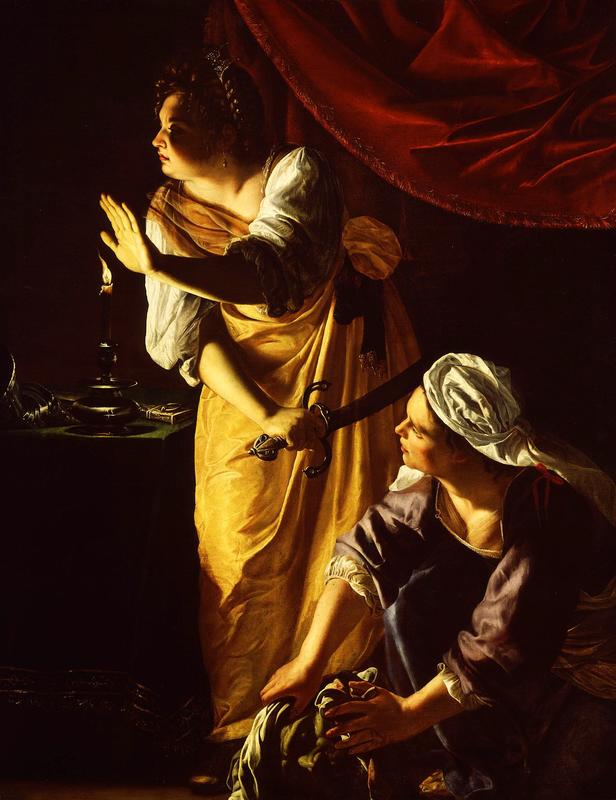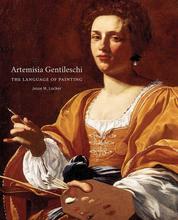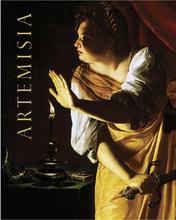More about Judith and Her Maidservant with the Head of Holofernes
- All
- Info
- Shop

Contributor
Gentileschi took a page from Caravaggio’s book for this masterpiece of violent contrasts and harsh lighting.
The stoic figures of Judith and her maidservant, however, are trademarks of Artemisia’s own work. Holofernes’ grisly end was just one of many stories that inspired her brutal depictions of resolute young females conquering male adversaries. No source material communicated female resilience quite so adeptly as the Book of Judith. When the Assyrians lay siege to the city Bethulia, the widow Judith captivated general Holofernes with her beauty. The enemy commander dropped his guard, invited the young lady into his tent, and fell into a deep, drunken sleep, allowing Judith to saw his head off and becoming fodder for thousands of morbid Baroque paintings.
Gentileschi chooses a gentler moment in the tale for this tableau. She forgoes the gratuitous head-sawing of the acclaimed artwork she had painted years prior, in all its gory glory. Judith has slayed her adversary and now checks for witnesses, lit among the shadows of the enemy’s lair. Her young maidservant stows the gray head in a sack, readying to tow the unlikely booty back to Bethulia. Their moment of silent triumph is untarnished by Holofernes’ grotesque head, which is relegated to a shadowy edge of the artwork. Not a single blood stain is to be found. Is the dubious cleanliness of Judith’s dress and hands an appeasement of delicate 17th century sensibilities, or a testament to the heroine’s decapitation prowess?
Critics attribute the graphic power plays of Gentileschi’s greatest works, including Judith Beheading Holofernes and Jael and Sisera, to a long and painful rape trial that plagued her teenage years. Agostino Tassi, a peer of her father’s, had raped the young artist, then promised her marriage to save her endangered reputation. Tassi was no stranger to deception, having changed his name and birthplace to feign nobility. Obsessed by grandeur, Tassi also falsified his own adoption by a marquess. He was a serial rapist, his victims including his own sister-in-law, and was said to have contracted bandits to assassinate his wife, who had gone inexplicably MIA.
Don’t be fooled; the 1997 film "Artemisia" would have you believe that Tassi and Gentileschi’s story was one of starcrossed lovers, not rape and murderous impulses. Works like this one are a demonstration of Gentileschi’s unwavering spirit; she relentlessly celebrated female solidarity and strength in a society devoid of gender equality.
Sources
- “Agostino Tassi.” Wikipedia. August 20, 2017. Accessed January 31, 2018. https://en.wikipedia.org/wiki/Agostino_Tassi.
- “Artemisia (film).” Wikipedia. December 6, 2017. Accessed January 30, 2018. https://en.wikipedia.org/wiki/Artemisia_(film).
- “Artemisia Gentileschi.” Wikipedia. January 27, 2018. Accessed January 31, 2018. https://en.wikipedia.org/wiki/Artemisia_Gentileschi.
- “Book of Judith.” Encyclopedia Britannica. July 20, 1998. Accessed January 30, 2018. https://www.britannica.com/topic/Book-of-Judith#ref262199.
- “Judith and her Maidservant (Detroit).” Wikipedia. September 8, 2017. Accessed January 30, 2018. https://en.wikipedia.org/wiki/Judith_and_Her_Maidservant_(Detroit)
- “Judith and her Maidservant with the Head of Holofernes.” Detroit Institute of the Arts. 2018. Accessed January 30, 2018. https://www.dia.org/art/collection/object/judith-and-her-maidservant-he….
Featured Content
Here is what Wikipedia says about Judith and Her Maidservant (Detroit)
Judith and Her Maidservant is one of four paintings by the Italian baroque artist Artemisia Gentileschi that depicts the biblical story of Judith and Holofernes. This particular work, executed in about 1623 to 1625, now hangs in the Detroit Institute of Arts. The narrative is taken from the deuterocanonical Book of Judith, in which Judith seduces and then murders the general Holofernes. This precise moment illustrates the maidservant Abra wrapping the severed head in a bag, moments after the murder, while Judith keeps watch. The other three paintings are now shown in the Museo di Capodimonte in Naples, the Palazzo Pitti in Florence, and the Musée de la Castre in Cannes.
The 2001 exhibition catalogue on Artemisia Gentileschi and her father Orazio remarked that "the painting is generally recognized as Artemisia's finest work". Others have concurred, and the art historian Letizia Treves concluded that, with this painting, "Artemisia rightly takes her place among the leading artists of the Italian Baroque."
Check out the full Wikipedia article about Judith and Her Maidservant (Detroit)















